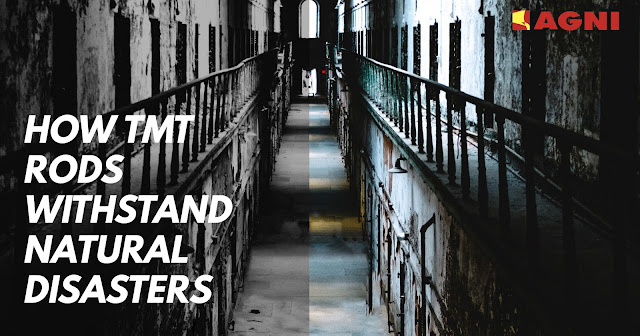TMT Steel and it's contribution in protecting structures from disasters.
With the loss of countless lives, along with economic damages of more than $3.30 billion, India was one of the most disaster-hit countries back in 2015. Measures on various levels are to be implemented to face these natural calamities that are a direct threat to our lives and property. To avoid structural failures in an event of a natural disaster, we must incorporate building codes that set minimum specifications for design and construction as a powerful tool for mitigating the effects of natural hazards. One of the ways to do that is to promote the use of Reinforced Cement Concrete building techniques for commercial constructions.Research is continually underway to find solutions to limit the damage caused by hurricanes, tornadoes and earthquakes, due to a direct and extreme threat to life and property.
Here are a few reasons why steel protects our constructions during every natural calamity:
Earthquakes: Constructions in the earthquake-prone regions are recommended to follow strength/ductility promoting guidelines. Earthquakes destroy and damage primarily older constructions despite being built in line with earthquake safety regulations. Ductile structures are capable of sustaining large amounts of damage without significant degradation in strength or stability. Steel, possessing high ductility, can endure significant damage to the structure (such as beams bending and buckling) without failures. This helps to reduce the earthquake’s load on the building, thus protecting its residents. Our highly ductile TMT Steel rods are recommended by structural engineers for their extreme strength.
Floods: During floods, the lack of implementation of protective building methods, such as retaining structures and dams, can worsen the conditions. Both the ongoing and the finished constructions are threatened by daily wear & tear, and failures, along with the possibility of corrosion, following the exposure to water. Corrosion thus reduces the longevity of the rods and structural integrity. Adding a protective layer of paint or anti-corrosive material can prevent the steel rod from rust. Agni Steels CRS (Corrosion Resistant Steel) rods offer high resistance to corrosion and decay so that your constructions survive such extreme floods.
Winds: Winds can be considered as natural disasters when they are unusually strong. Generally, buildings can be damaged by strong winds when the construction materials and technology are inappropriate.The two most common failures during a tornado are roofs lifting off their frames and homes being pushed off their foundations. It is recommended that metal connectors be used for optimal strength and wind resistance (up to 210kmph). A TMT rod’s superior grip over concrete ensures an unbreakable bond that can withstand destructive winds.
A threat to the construction of other factors like fires, decay, pests and insects, daily wear and tear, etc. is minimized by incorporation of high-quality TMT bars. While compromising the costs of building materials, the builders are recommended to avoid overlooking environmental factors and natural disasters, as the longevity and stability of a building are paramount. Agni Steels is constantly perfecting its manufacturing methods to provide the strongest TMT bars to the masses to help in the prevention of structural damage and loss of life.








while speaking about construction, TMT Bars play a important role which makes a building strong and long lost for ever. Thanks for sharing this blog.
ReplyDeleteThe relentless wrath of natural disasters, such as earthquakes, hurricanes, and tornadoes, is a formidable adversary to structural integrity and human lives, as evidenced by the grievous losses experienced by countries like India in recent years. Amidst the turbulent trials, one knight in shining armor emerging prominently is Thermo Mechanically Treated (TMT) steel, playing a pivotal role in fortifying structures, making them more resilient against the unforgiving forces of nature.
ReplyDelete